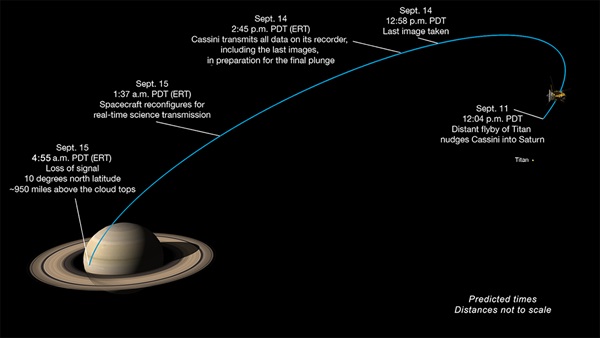Goodbye, Cassini
Posted on Categories Discover Magazine

Today, Cassini takes its final photograph, calls home with its last pre-packed data, and transitions to continuous real-time transmission to squeeze science out of every last final second before destruction.
At 12:58 p.m. Pacific time on September 14, 2017, the Cassini spacecraft will look around Saturn’s system for the final time. Its cameras will capture a wide view of the planet and its rings, watch Enceladus set behind Saturn, glance at a half-phase hazy Titan, check one last time if the “Peggy” disturbance in the outer rings has broken free as a new moon, and observe the strange shape of propellers in the rings. Finally, Cassini will look ahead into the darkness on the night side of Saturn, taking its final photograph straight ahead at the patch of the gas giant that will soon destroy it.
By 1:22 p.m., Cassini’s camera will shut down for the final time. The spacecraft will align its antenna with Earth and downlink the photographs via the Deep Space Network. The transmission will start in Goldstone, California, then get handed off to Canberra, Australia, as Earth turns below the steady stream of data.
For 13 years, Cassini has explored, gathered data, and sent it back to Earth in discrete packages later. That changes just after midnight on September 15th, when the spacecraft transitions to real-time transmission of streaming data from its few instruments still switched on.
In the wee hours of the morning, the people who have dedicated their careers to Cassini will gather to stand vigil, the core operations staff at Mission Control in the Jet Propulsion Laboratory and the remaining scientists and engineers across town at the California Institute of Technology. At 4:00 a.m. Pacific time, NASA TV will stream a live broadcast so others around the world can follow along.
The spacecraft is expected to start feeling the effects of Saturn’s atmosphere at 1,193 miles (1,920km) above the cloud tops at 4:43 a.m. Pacific time. It will use its thrusters to try to maintain an orientation pointed at Earth and relaying data for as long as possible, but the spacecraft designed to operate in deep vacuum will rapidly be overcome by Saturn’s relentless storms. Wrenched out of position, Cassini’s signal will be lost with no chance of recapture.